NA Collegiate Growth: Driving the Future of University Esports
Updated On: October 21, 2025 by Aaron Connolly
Understanding NA Collegiate Growth
North American collegiate esports has grown fast, fueled by dedicated programs, big investments, and organized competitive structures.
Major universities now hand out scholarships, hire coaches, and set up professional facilities that look a lot like traditional sports programs.
Key Drivers Behind Growth
Universities have really changed their esports programs by investing in infrastructure.
Many schools now offer gaming facilities with high-end PCs, pro-level peripherals, and spaces just for practice.
They see esports as a real recruitment tool.
Scholarships pull in talented players who could easily pick another school.
This cycle pushes universities to keep investing so they can snag top talent.
Corporate sponsorships have become a huge part of program expansion.
Big names like Intel, NVIDIA, and energy drink companies team up with universities to back teams and tournaments.
These partnerships bring in money for gear, travel, and coach salaries.
The NCAA has started to show interest in esports, which hints at mainstream acceptance.
Although full integration hasn’t happened yet, conversations about official NCAA governance keep going.
If that happens, it could bring standardized rules and more legitimacy.
Student demand keeps pushing schools to support esports.
Gaming clubs and unofficial teams prove there’s real interest, so universities step up and make programs official.
A lot of these programs actually started as student projects before the schools got involved.
Historical Milestones in NA Esports
Back in 2009, Robert Morris University broke new ground by offering the first esports scholarships.
This move helped make competitive gaming a real thing in higher ed.
The National Association of Collegiate Esports (NACE) formed in 2016, bringing structure to university programs.
Now, NACE has over 170 member schools across North America, with set seasons and championship tournaments.
In 2018, universities started building dedicated esports arenas.
Places like University of California Irvine opened multi-million pound facilities with full broadcast setups.
Between 2017 and 2019, major publishers jumped in.
Riot Games kicked off the League of Legends College Championship, and Blizzard rolled out Tespa for university competitions.
These partnerships brought prize pools and professional broadcasts.
When COVID-19 hit in 2020-2021, traditional sports hit pause, but esports kept going.
Universities doubled down on remote competition and online training.
By 2022-2023, North American schools offered over $16 million in scholarships, showing they’re still all-in on collegiate esports.
Role of Riot Games in Collegiate Esports
Riot Games has really shaken up collegiate esports with direct investment and structured tournaments.
They support both League of Legends and VALORANT at the university level, building clear paths for student competition.
Official Tournaments and Support
Riot Games kicked off collegiate esports support in 2015 with the North American Collegiate Championship (NACC).
That launch marked the start of formal university-level competition.
In 2018, they rolled out College League of Legends (CLOL).
Since then, it’s gotten much bigger.
The 2023 Championship brought together 32 teams fighting for a £190,000 prize pool.
Earlier in 2023, College VALORANT launched.
That move shows Riot wants to grow beyond just League of Legends in the college scene.
Riot works with the Riot Scholastic Association of America (RSAA) to run the show.
In August 2025, they announced a three-year deal with GGTech Entertainment to streamline their North American college programs.
Now, this partnership acts as a “one-stop-shop” for everything college esports.
It covers CLOL, College VALORANT, and other club programs under one roof.
Influence on College LoL and College VALORANT
College LoL has become the flagship collegiate esports program.
Schools all over the country join in through conference-based qualifiers.
The setup looks a lot like pro leagues.
Teams play regular seasons, then move on to championship tournaments.
College VALORANT is Riot’s big move into tactical shooters for colleges.
It launched with a structure that feels pretty similar to College LoL.
Both programs stick to consistent rules and formats.
That standardization helps schools build lasting esports programs.
Riot handles the tech support, tournament organizing, and prize money.
They also set up community guidelines so third-party tournaments can exist alongside official ones.
RSAA stays involved in strategy and operations, even with the GGTech partnership.
That keeps things steady with university relationships and existing programs.
UNIVERSITY Esports NA Program
UNIVERSITY Esports NA connects schools across the US and Canada with structured competitive gaming.
The program offers $600,000 in scholarship opportunities and gives students a shot at competing in big titles like League of Legends and Valorant.
Structure and Operation
UNIVERSITY Esports NA works as a broad collegiate gaming network.
Schools from both countries join in seasonal competitions for multiple games.
Main Competition Titles:
- League of Legends – 5v5 strategic play
- Valorant – Tactical first-person shooter
- Rocket League – Vehicle-based sports
- Overwatch 2 – Team shooter
The program runs structured seasons with brackets and playoffs.
Teams compete at varsity or club level, depending on how much their school invests.
Schools get help with program development.
That means coaching resources, tournament organization, and guides for handing out scholarships.
Key Benefits for Schools:
- Access to a $600,000 scholarship pool
- Standard competition formats
- Cross-border networking
- Help with program growth
Member schools range from big universities to small colleges.
The program’s open setup lets schools with all kinds of budgets get involved.
Community Impact
This program opens real doors for student recruitment and keeping students engaged.
Schools use esports to draw in students who might not care about traditional sports.
Students pick up hands-on experience by joining teams.
A lot of them build skills like communication, strategy, and digital teamwork—stuff that actually carries over to real jobs.
Student Outcomes:
- Scholarship support for education
- Leadership growth through team roles
- Career connections in gaming
- Campus community building
Cross-border play introduces students to different gaming cultures.
Canadian and American teams face off often, creating international ties.
The program meets the rising need for legit college esports.
Students who didn’t have post-secondary gaming options before now get a clear path.
Some participants go pro, while others get into esports management, broadcasting, or similar careers.
Esports Leagues and Competitions
College esports has really become a structured world of competitive leagues that look a lot like traditional college sports.
The biggest competitions are College League of Legends (CLOL) and College VALORANT (CVAL), but there are also tons of specialized tournaments that help students move from campus gaming into pro careers.
College LoL (CLOL)
College League of Legends stands out as the top collegiate esports contest in North America.
Schools put together their best five players for seasons that end in big championship finals and solid prize pools.
CLOL works with partner leagues like ECAC and NECC.
These groups offer qualifying paths to national playoffs.
Last year, NECC got three championship bids and ECAC grabbed one playoff spot.
The competition runs from September to May.
Teams play regular season matches, then move into regionals.
Top teams pick up scholarships and sometimes even get scouted by pro teams.
Key CLOL Features:
- 5v5 format, just like the pros
- Scholarship awards over £100,000 every year
- Direct pipeline to pro League of Legends teams
- Regular season and playoff setup
Most university esports programs focus on CLOL because of its reputation.
Over 200 schools join each year, across different skill levels.
College VALORANT (CVAL)
College VALORANT has quickly become the second-biggest collegiate esports event.
The game’s popularity with students has made tournament numbers explode since 2020.
CVAL uses structures similar to pro VALORANT events.
Teams of five play best-of-three matches in skill-based divisions.
Universities can enter more than one squad in different tiers.
Riot Games backs the competition, which means steady prize pools, broadcasts, and pro development chances for players.
Tournament Structure:
- Premier Division: Top university teams
- Division 1: Competitive programs
- Division 2: Developing programs and community colleges
- Open Division: Entry-level play
Registration usually costs between £1,200-£3,200 a year, depending on league.
Sign up early in September and you get 20% off.
Other Notable Tournaments
Outside the big leagues, lots of specialized tournaments serve different gaming scenes.
These events often act as stepping stones into bigger competitions.
Counter-Strike 2 tournaments draw plenty of university teams.
Schools compete through ECAC, which actually offers the most game variety with 21 different titles.
Rocket League keeps steady college interest, with both solo and team events.
Emerging Competitions:
- Fortnite: Not huge yet, but interest is rising
- Super Smash Bros. Ultimate: Strong fighting game crowd
- Overwatch 2: Not as big as before, but still going
- Call of Duty: Separate leagues like Collegiate CoD run things here
Many tournaments charge per game, usually around £450-650 a year.
That lets smaller programs try out games before jumping into full league memberships.
Sim racing and sports games give students other options.
FIFA, NBA 2K, and iRacing events often have lower entry fees and focus more on regional play.
Technology’s Impact on Collegiate Esports
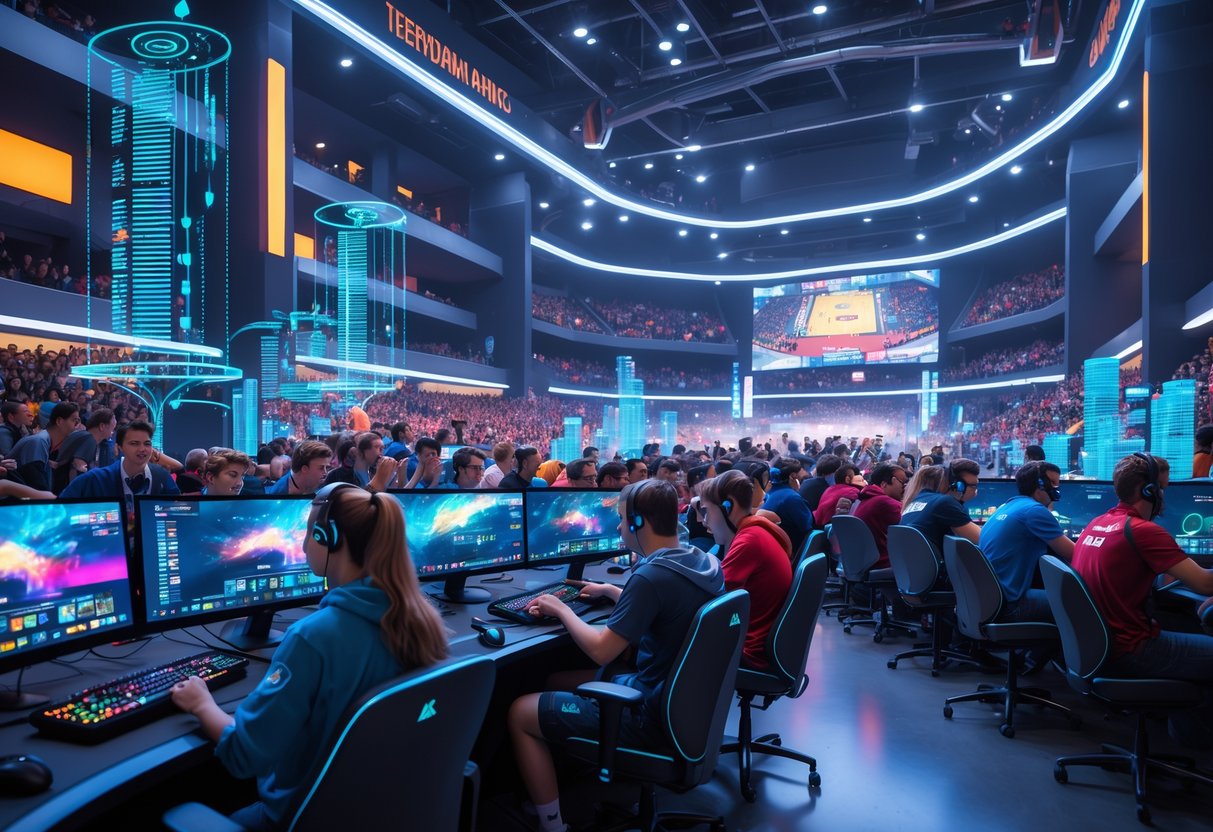
Modern tech has totally changed how universities handle competitive gaming.
From dedicated gaming centers with top-tier hardware to cloud-based platforms that kill lag, colleges are putting big money into digital infrastructure to make high-level esports possible.
Gaming Infrastructure at Universities
Universities all over North America are building gaming facilities that could rival pro venues.
These spaces usually have high-refresh monitors, mechanical keyboards, and graphics cards that run games at top frame rates.
Must-Have Infrastructure:
- Gaming PCs with RTX 4070+ cards
- 240Hz monitors for that extra edge
- Gigabit internet with backup lines
- Streaming setups for match broadcasts
Lots of schools have realized that reliable internet matters way more than fancy gear.
A university might drop £50,000 on gaming chairs but still lose matches because of lag.
Honestly, some schools overspend on flashy stuff and forget to fix their networks.
Community colleges have made it work with simpler setups.
They focus on solid internet and mid-range laptops instead of tricked-out rigs.
Digital Platforms and Innovations
Cloud gaming and network tools are changing how college teams practice and play.
Services like ExitLag cut down ping and packet loss, so teams can play online without hiccups.
Key Platform Types:
- Tournament organization (FACEIT, Challengermode)
- Performance analytics (Mobalytics, Aim Lab)
- Network optimization (ExitLag, Haste)
- Team chat (Discord, TeamSpeak)
Some bigger schools are trying out virtual reality for training.
Teams use VR for reaction drills and strategy planning, especially in shooters.
AI-powered coaching tools are popping up, too.
These platforms break down gameplay videos and give advice—even if a school can’t afford a full-time coach.
Quick tip: Schools can start with free tools like Discord and upgrade to fancier analytics as their programs grow.
The best college esports programs mix good hardware with smart software, instead of just blowing the budget on expensive gear.
ExitLag’s Partnership and Influence

ExitLag’s naming sponsorship of UNIVERSITY Esports NA actually helps thousands of college students by cutting down lag and offering exclusive discounts. The partnership really tries to tackle those annoying connectivity issues that mess with competitive performance in League of Legends and VALORANT tournaments.
Benefits to Students and Faculty
Students in UNIVERSITY Esports NA get exclusive discounts on ExitLag’s platform, plus some cool promotional gifts throughout the 2024/25 season.
ExitLag runs five campus activations across North America, so students can get hands-on with network optimisation tech.
Faculty members get to see demos that show how connection stability impacts competitive gaming. These sessions give educators a better sense of the technical needs behind collegiate esports programs.
ExitLag’s campus visits pull in the wider university crowd, not just the players. Even students who aren’t into esports get introduced to competitive gaming ideas.
This kind of exposure builds more support for collegiate esports in academic circles.
Quick win: Students can try ExitLag’s free trial during major tournaments and see their ping drop right away.
Technical Advantages for Competitors
ExitLag’s AI-powered platform actively maps multiple data routes in real time, fighting off lag, jitter, and packet loss—the usual headaches for competitive players.
The system reroutes connections as soon as it spots a network issue.
College players in official Riot Games tournaments get more stable connections during those clutch moments. ExitLag’s global server network keeps things consistent, whether students are gaming from dorm rooms or off-campus apartments.
VALORANT players, in particular, notice the benefits—millisecond timing can make or break a shot. League of Legends competitors see their team fights and ability timing get sharper, too.
Just a heads up: Network optimisation works best if you already have a decent internet connection. It can’t magically fix terrible Wi-Fi.
Building and Recruiting Collegiate Esports Teams
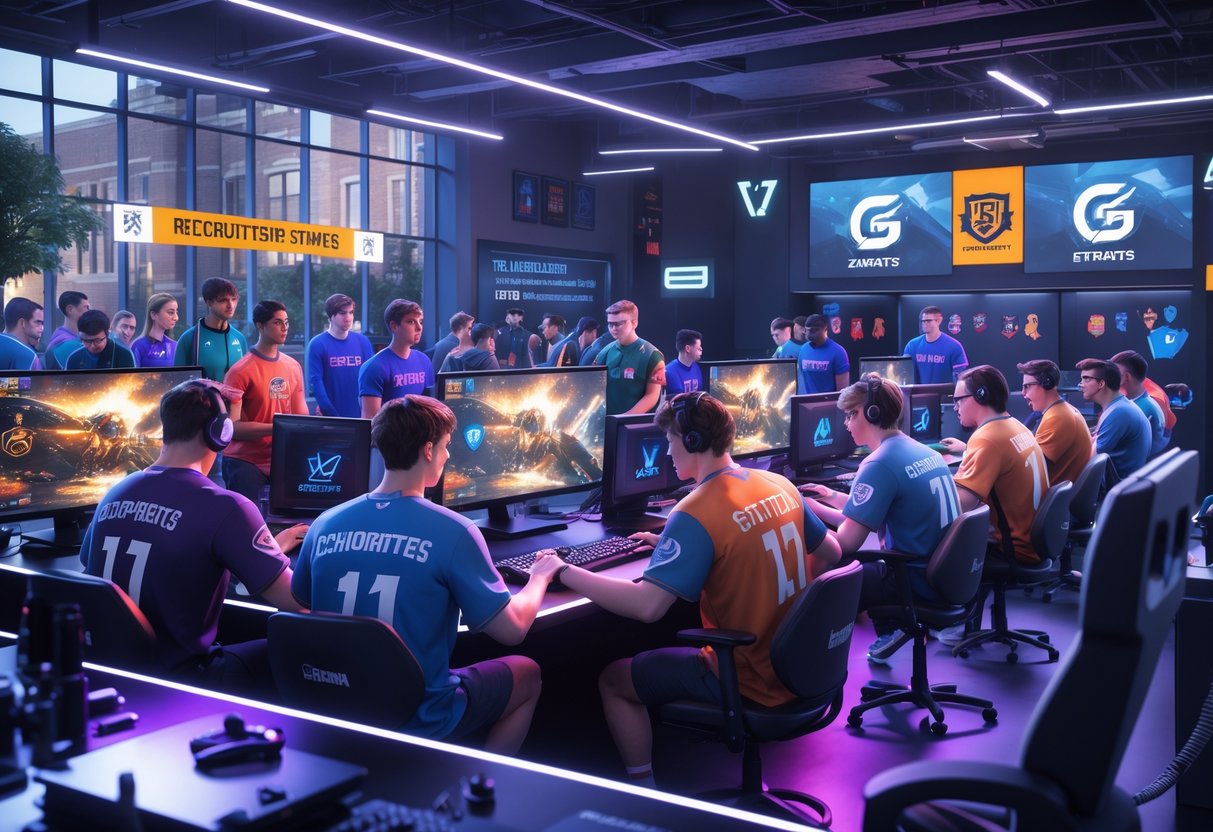
Building a strong collegiate esports team isn’t simple. You need structured tryouts and smart scouting.
Universities now use digital recruitment to find talent from all over, but they still keep selection standards high.
Team Formation and Tryouts
Most universities kick off tryouts at the start of each term. These usually involve online skill assessments through ranked gameplay.
Students have to show their current rank in the games they want to play. For League of Legends, Diamond rank or higher is often the bar. Valorant teams look for Immortal or Radiant tier players.
The tryout process has three main steps. Players submit gameplay footage and rankings first.
Then, they play scrims with the team. Finally, coaches evaluate communication and teamwork during practice.
Equipment requirements can be a barrier. Most programs provide gaming PCs and gear, but students still need solid internet for online tryouts.
Many universities split tryouts for varsity and club teams. That way, more students get a shot, no matter their skill level.
Player Scouting Strategies
Coaches have changed how they scout talent thanks to digital tools. Unlike traditional sports, esports lets coaches scout worldwide using online leaderboards and tournament data.
They keep an eye on platforms like op.gg, tracker.gg, and in-game ranking systems.
Coaches look for players with steady performance and good behavior scores.
Tournament participation stands out as a big deal. Players who compete in amateur leagues or online events show commitment beyond casual gaming.
A player’s social media presence matters a lot now. Coaches check out streams, Discord activity, and online reputation. Toxic behavior often knocks out otherwise skilled candidates.
Some programs team up with local gaming centers and high schools to spot talent early.
Scholarship allocation really depends on the school. Some offer full tuition to top players. Others hand out partial scholarships or equipment stipends to build deeper teams.
Coaching and Player Development
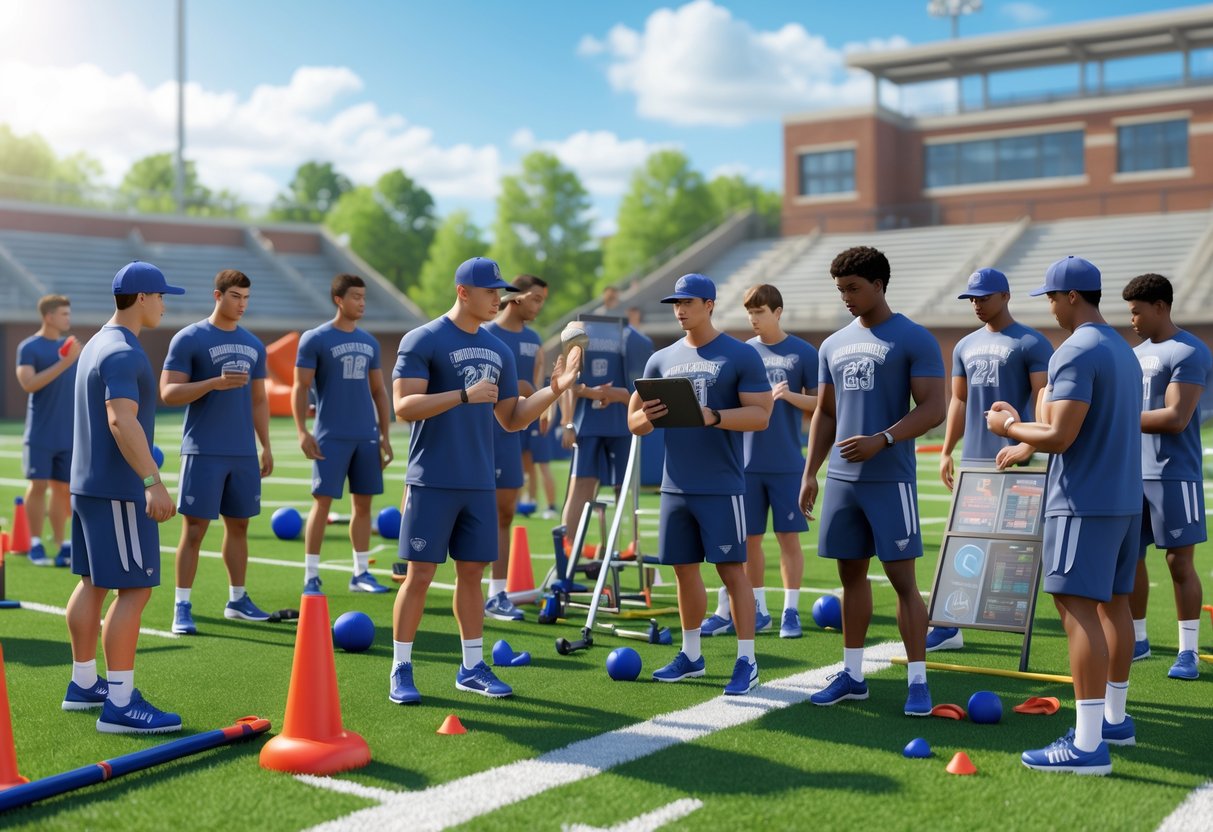
Coaches play a huge role in shaping esports athletes. They focus on skill development, mental conditioning, and strategy.
Professional training programs mix technical gameplay instruction with mentoring to help players grow both in and out of the game.
Role of Coaches
Esports coaches do a lot more than traditional coaches. They break down gameplay footage, create strategies, and keep team dynamics running smoothly during high-stress tournaments.
Technical Development sits at the heart of coaching. Coaches and players review match replays together, picking out mechanical errors and decision-making slip-ups.
They set up practice schedules with a mix of individual drills and team exercises.
Mental Coaching is just as important. Many coaches now use sports psychology to help players handle tournament anxiety and stay focused during long matches.
Technology has become a staple of coaching. Coaches use:
- Performance tracking software to check reaction times and accuracy
- Communication platforms for remote practices
- Video analysis tools for deep-dive replays
Most pro teams now have a full staff: head coaches, analysts, and mental performance specialists. It’s a setup that borrows from traditional sports but suits esports’ quirks.
Training and Mentorship Programmes
Structured training programs are popping up in all the big esports titles. These usually run 6-12 months, blending gameplay lessons with life skills.
Academy Teams have become the main development pipeline. Big names like G2 Esports and Team Liquid run academy programs where young players train with pros. These programs aren’t cheap—organizations spend £50,000-£200,000 per player each year.
University Programs now offer official esports coaching certificates. The University of Staffordshire and others have courses built for competitive gaming.
Training schedules look a lot like pro sports. Players practice 8-12 hours a day, splitting time between solo mechanics and team strategy. Coaches keep an eye out for burnout, since esports demands such intense focus.
Mentorship Relationships reach beyond just gameplay. Veteran players often help rookies with career choices, contract talks, and moving between teams. This kind of support can be a game-changer in the industry.
Student Experience in NA Collegiate Esports
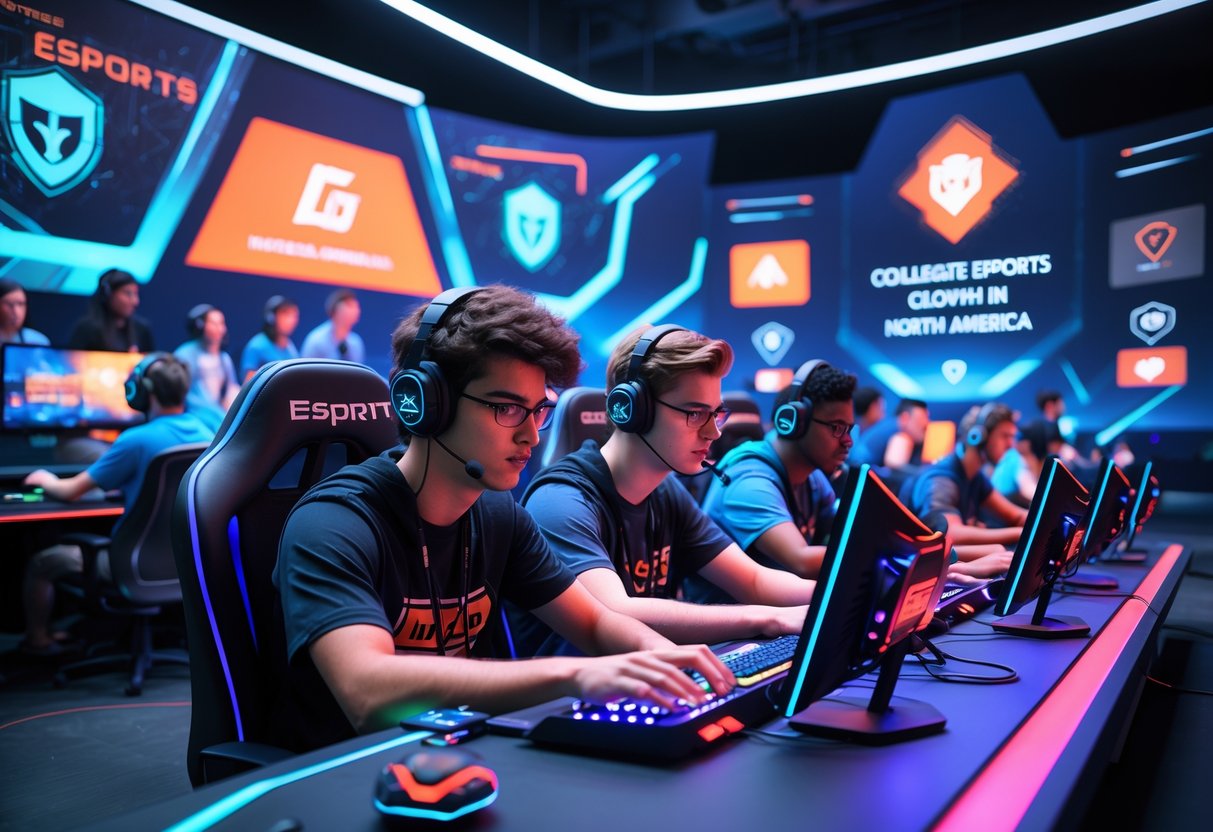
Student athletes in collegiate esports juggle heavy gaming schedules with academic responsibilities, all while building tight-knit communities.
These programs foster inclusive spaces where students sharpen their competitive edge and grow their professional networks.
Academic Balance and Player Wellbeing
Balancing coursework and esports training isn’t easy. Most university programs now stick to structured schedules and cap practice at 15-20 hours a week during the term.
Study halls are now the norm. Teams set aside time for homework and prepping for exams.
Many programs require minimum GPAs—usually 2.5 or higher—to keep players on track.
Universities are hiring dedicated academic advisors for esports athletes. These advisors help students pick degree paths that fit their gaming interests, such as:
- Game design and development
- Sports management
- Digital marketing
- Computer science
Mental health support is essential. Students face performance anxiety, online harassment, and weird sleep schedules thanks to late-night tournaments.
Several schools now offer counseling services with staff who get the gaming world. Quick win: Students who stick to regular sleep schedules—even during tournaments—say they perform better.
Time management tools like Notion and Forest help players balance practice, matches, and studying.
Inclusion and Community Engagement
Collegiate esports programs work hard to welcome students from all backgrounds and skill levels. Many schools run several team tiers, from varsity to casual clubs.
Gender inclusion initiatives try to tackle the male-heavy nature of esports. Women’s-only tournaments and mentorships have boosted female participation by 35% at lots of schools.
Universities host watch parties for big esports events. These gatherings let casual fans and serious players mingle.
Club structures often include:
- Varsity squads (scholarship players)
- Junior varsity teams
- Rec leagues
- Coaching and analysis positions
Students who don’t make the competitive cut still find a place as content creators, statisticians, or event organizers. These roles offer valuable experience for future esports careers.
Cross-cultural connections just happen in gaming. International students often make their first campus friends through esports clubs, bonding over games even when language is a barrier.
One warning: Some programs still struggle with toxic behavior that shuts out newcomers. The best programs set clear conduct rules and act fast against harassment.
Impact of Scholarships and Sponsorships

Scholarships and corporate sponsorships make collegiate esports possible for more students by providing financial pathways. Big brands now pour millions into university esports, shifting how programs run and expand.
Financial Support for Players
Universities now hand out esports scholarships ranging from £500 up to full tuition. Top schools like University of California Irvine offer packages that cover equipment, coaching, and even living costs.
Many scholarships target certain games or skill levels. League of Legends and Overwatch players usually see the most options.
Some programs require students to keep up their grades and gaming performance.
Merit-based awards weigh both gameplay and academics. Students often need a 3.0 GPA and proof of tournament experience or high in-game rank.
Need-based scholarships help students who can’t afford pricey gaming setups. These programs know that equipment costs can block talented players from joining.
Quick win: Go straight to university websites and search for “esports scholarships.” Third-party databases often miss the best ones.
Private foundations pitch in, too. The Jaime and Blanca Jarrín Foundation recently gave out over £40,000 to students in related fields.
Role of Corporate Partners
Corporate sponsors keep collegiate esports running. Companies like ExitLag sponsor university tournaments and provide tech that boosts competitive play.
Equipment partnerships give universities gaming PCs, monitors, and networking gear worth tens of thousands. These deals usually include maintenance and upgrades.
Streaming platforms like Twitch and YouTube bring in revenue for university programs. Partnerships generate income from viewers and give students real broadcasting experience.
Tech sponsors—graphics card makers, peripheral brands—offer gear and sometimes internships. Students get industry contacts that can lead to jobs.
Corporate partners often ask for branding and tournament participation. Universities have to balance commercial deals with their educational missions.
Some sponsors focus on certain regions or games. Finding good-fit partners can make or break a program’s future.
Challenges and Barriers to NA Collegiate Growth

North American collegiate esports faces some real obstacles that hold back program growth and student involvement. Budget issues and the gap between amateur and pro play create tough roadblocks for both schools and players.
Infrastructure and Funding Limitations
Most universities have trouble providing enough resources for competitive esports. Unlike traditional sports, which have established funding, esports needs big upfront tech investments that many schools just can’t justify.
Equipment costs hit hard right away:
- High-end gaming PCs at £1,200–£3,000 each
- Pro monitors, peripherals, and gaming chairs
- Upgrades to high-speed internet
- Dedicated practice rooms with proper ventilation and power
A lot of programs get by with donated gear or student-owned setups. That leads to uneven practice conditions and puts teams at a disadvantage in competition.
Staffing is another headache. Universities often rely on grad students or part-time coordinators instead of full-time coaches.
Without solid mentorship and strategy, teams can’t develop the depth needed to compete at a high level.
Scholarship funding swings wildly from school to school. Some offer full rides, while others barely provide any support, creating a lopsided playing field that feels a lot like traditional sports divisions.
Bridging the Gap with Professional Esports
The pathway from collegiate competition to professional esports honestly feels a bit murky compared to what we see in traditional sports. This uncertainty makes it tough for programmes to build credibility and attract new students to their competitive teams.
Professional opportunities just aren’t clearly mapped out. Football and basketball have their draft systems, but esports careers? They mostly rely on who you know and how you perform at tournaments. Students often feel lost trying to figure out what comes after university-level play.
Skill gaps between levels throw up even more barriers. When collegiate players try to move up to semi-pro teams, they hit a wall. The jump in practice demands and strategy is huge, so a lot of students end up feeling unprepared for what’s next.
Industry connections still fall short in most university programmes. Without real relationships with pro organisations, students lose out on internships, coaching gigs, and player development opportunities.
Plenty of programmes stick to competition and overlook the wider esports industry. Students need hands-on experience with broadcasting, event management, and the business side if they want to break into jobs outside of playing professionally.
Future Prospects for NA Collegiate Esports
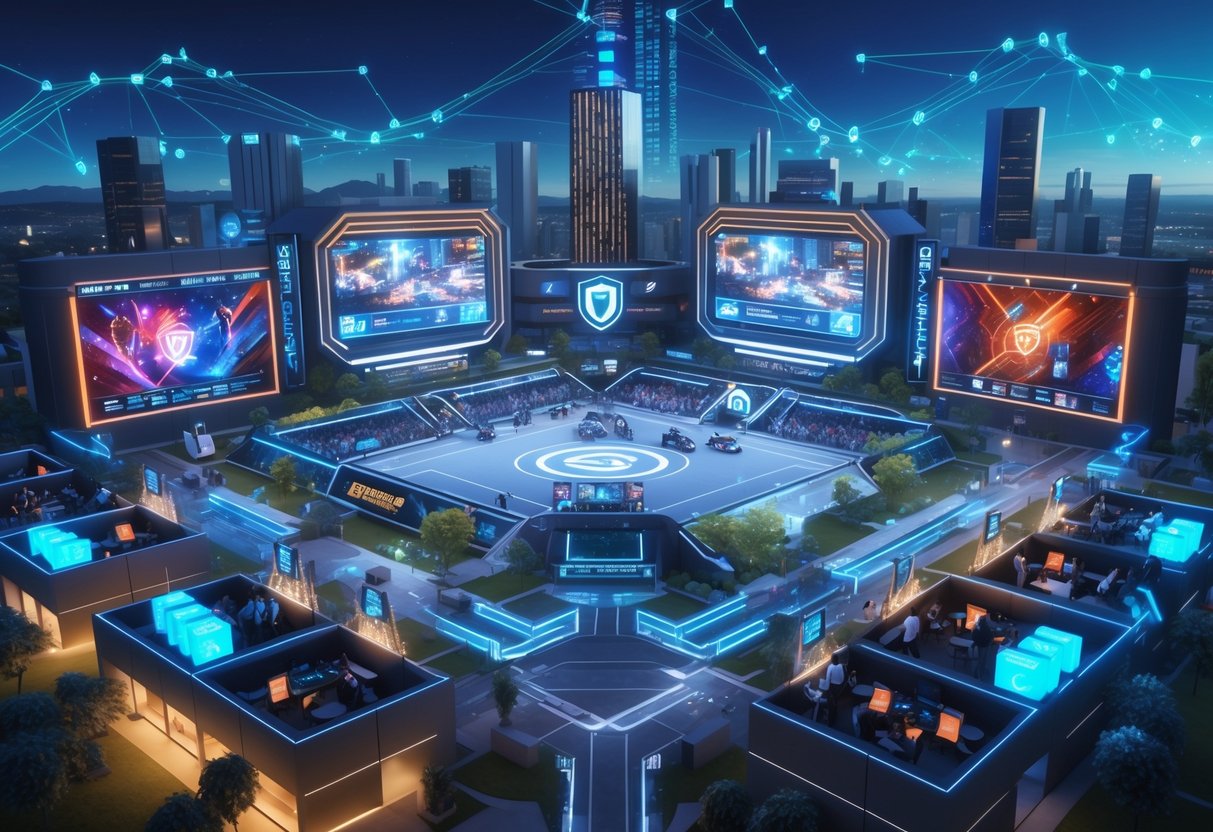
The next five years look set to shake up North American collegiate esports, thanks to technology advances and new global partnerships. Universities are already gearing up for mobile gaming and cross-border tournaments that could totally change what’s possible for students.
Predicted Trends in Growth
Mobile gaming could really flip the script for collegiate esports by 2027. Universities in both Canada and the US have started running mobile-first tournaments in games like Clash Royale and Mobile Legends.
We’re likely to see over 600 institutions with varsity esports programmes by 2026. That’s a 20% jump from where things stand now, mostly because students are asking for it and schools see the recruitment benefits.
Hybrid competition formats are on the way in. Students will play both online and at physical venues, which helps cut travel costs but still keeps that team spirit alive.
Here’s where the growth seems strongest:
- Scholarship funding spreading to more game titles
- Academic degree programmes popping up in esports management and broadcasting
- Top-notch facilities becoming a big selling point for universities
With the industry growing at a projected 17.5% annually through 2027, more corporate sponsors will want in. This should mean steadier funding for teams and better training setups.
Quick win: If you’re a university planning an esports programme, get your infrastructure sorted first—then build teams around what students want.
Opportunities for International Collaboration
Cross-border tournaments between North American and European universities are picking up steam. Canadian schools have started teaming up with UK universities for League of Legends championships.
Student exchange programmes are starting to include esports scholarships. Players can study abroad and still compete through online leagues.
International partnerships bring some cool perks:
- Coaching expertise shared between different gaming communities
- 24-hour tournaments that work across time zones
- Cultural exchange right inside the gaming scene
Asia-Pacific partnerships could be the next big thing. North American universities want to work with South Korean and Japanese schools, since those countries really know their stuff in esports.
Heads up: International events need careful planning—visas and academic calendars can get tricky when schools are in different countries.
With the global esports market hitting $33.05 billion in revenue in 2023, there’s a lot of room for universities and gaming companies to team up on joint projects.
Frequently Asked Questions

Students and schools have plenty of questions about esports programmes, scholarships, and the future of competitive gaming. Here are some answers to the most common concerns about joining collegiate esports and how university gaming programmes actually work.
What are the criteria for esports scholarships at universities?
Most UK universities that offer esports scholarships want students with real competitive gaming experience. They usually look for strong ranks in big titles, tournament history, and solid grades.
Applicants often need to keep at least a 2.5 GPA and show skill in games like League of Legends, Counter-Strike, or Overwatch. Some programmes ask for gameplay videos or live tryouts, which can feel a bit nerve-wracking.
Scholarship amounts really vary. Full rides are rare, but partial awards—think £1,000 to £5,000 a year—are popping up at more schools building their esports offerings.
How do college esports rankings influence collegiate growth in the field?
University esports rankings push programmes to develop by creating competition between schools. Programmes that rank higher pull in better players, more funding, and more media attention. That’s just how it goes.
Schools invest in gaming facilities and coaching so they can climb the rankings. Students benefit from this with better training and upgraded equipment.
Rankings also shape how schools recruit. Top programmes can be picky with scholarships, while newer ones sometimes offer bigger financial incentives to attract good players.
Which video games are most commonly included in college esports leagues?
League of Legends is still the go-to collegiate esports title worldwide. Almost every university team has a LoL squad because the tournament scene and prize pools are so steady.
Counter-Strike and Valorant rule the tactical shooter space. Rocket League is a favorite for newer programmes since it’s easier for beginners to pick up.
Fighting games like Street Fighter and Tekken are picking up steam in college competitions. FIFA covers the sports gaming crowd, and Overwatch still draws plenty of players even if viewership wobbles sometimes.
Can you explain the structure of the Esports Collegiate Conference?
The Esports Collegiate Conference runs as a governing body that organises competitive seasons for member universities. Schools play in divisions based on programme size and skill.
Regular seasons usually run in autumn and spring. Teams rack up points in weekly matches, and playoffs crown conference champs for each game.
Members get standard rulebooks, referee training, and help with broadcast production. The conference also offers coaching certification and academic credit for students.
What opportunities are available for students at institutions that are part of the NACE Starleague?
NACE Starleague members get access to structured competitive seasons with set match schedules. Students compete for more than £100,000 in annual scholarship prizes across different games.
Academic perks include internships in sports management, training in broadcast production, and event organisation experience. Many schools offer academic credit for playing or taking on leadership roles in esports.
Students can also build professional networks through industry events, get help with career placement, and join mentorship programmes that connect them with esports pros.
How does participation in Alpha Chi Omega’s Collegiate Growth Academy benefit students interested in esports?
Alpha Chi Omega’s Collegiate Growth Academy puts the spotlight on leadership development and organizational skills, not just gaming.
Still, these skills come in handy for managing esports teams or organizing events.
Students pick up budgeting, project management, and team-building techniques—practical stuff for anyone running a university esports program.
The academy also offers networking opportunities that help students meet others who care about gaming initiatives.
The program costs £199 for the first three attendees per chapter. That fee covers accommodation and educational materials.
Students get hands-on experience with professional presentations and strategic planning. These skills open doors to esports career paths.


